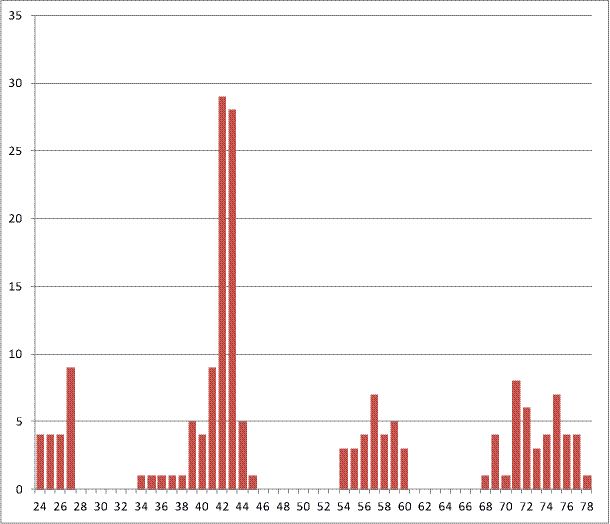3.10 Brass pins
From 1985 to 1999, a total of 719 pins were found in excavation. Their length varies from 2.4 to 7.8 cm, their diameter from 0.4 to 1.2 mm and their heads from 1 to 3 mm (n=179). Several groups can be distinguished: small pins of 2.4-2.7 cm, pins of 3.4 to 3.9 cm, pins of 4.0-4.5 cm, pins with a length of 5.4-6.0 cm, pins with a length of 6.8-7.2 cm and large pins of 7.5-7.8 cm (Chart 6, fig. 39). Interestingly, four types of pins are mentioned in a deed from 1590 (van Dillen 1929, nr. 789).
Chart 6 Length distribution of the pins.
The pins were discovered throughout the excavated area in the southeast. Of the 490 pins found there, 11.4% came from section A, 35.3% from section B, 8.4% from section C, 20.2% from section E, 9.0% from section F and 7.4% from section J. A concentration of finds occurs in the south and east corners of the frame. However, pins are light and may easily have been moved around with moving sediment or by airlift, so a definite stacking location for the brass pins cannot be derived from this spread.
The pins are made of drawn brass wire. At one end the pins have a sharpened point; at the other a twisted pinhead is attached. The pinpoints are quite sharp; sometimes one side of the pin is sharpened over a longer surface than the other side. The pinhead mostly consists of two coils, usually twisted to the right, and occasionally to the left (fig. 40). Some pins have a thickened upper end instead of a twisted pinhead, but nevertheless seem to be complete (Raymakers 1996, 20).
Pins with a twisted head were manufactured from the beginning of the 16th to the first half of the 19th century. The Low Countries were an important exporter and during the first half of the 16th century most of the pins used in England were imported from there (Harsman 2010, 48). Amsterdam, Bremen and Gloucester were the centres of 17th-century pin-making (van Dillen 1929, nr. 789). In 16th and 17th-century Amsterdam, pin-making was typically a domestic industry, in which all family members were involved. In the second half of the 17th century, the Nieuwe Werk quarter (later called de Jordaan) had seven pin-makers’ alleys (Oldewelt 1946, 158-160; Baart 1977, 135). In later centuries, there was a trend towards the establishments of workshops (Baart 1977, 133).
A pin may be a simple artefact, but the process of pin-manufacturing was an elaborate one. First, the brass wire was cleaned and then drawn into the thickness required, cut to length and sharpened. Another (finer) wire was twisted to form the head. The heads were attached to the shanks by being struck with a heavy ram. The pins were then cleaned or yellowed, tin plated, polished and stuck into papers before being offered for sale (Philips 1821, 299-301).
From the 15th to the 18th century, pins were a luxury and expensive (Raymakers 1996, 27). In the 18th century, production processes changed. Pins were made in factories and became less expensive, but their appearance remained exactly the same. Adam Smith uses pin-making in his famous Wealth of Nations to show how productivity rises through division of labour, and describes the process in detail. To make one pin, eighteen actions had to be performed, which were done by ten people. One person performing these steps alone could make 20 pins a day. The ten people together could make 48,000 pins a day (Smith 1776, 5).[9]
Pins were used in handwork and needlework, for making clothes and hats, and for fastening clothes. In early modern times, sleeves and bodices were pinned to the rest of the clothes. According to Van Deijk it is unlikely that the pins were used for the textile shipment. We must therefore assume that they were packed separately. Paper packages as described in literature are likely to have been packed in larger packages, but we have no archaeological evidence as to how, and they barely contribute to the overall weight of the cargo. The trade in pins is documented in other ship finds such as BZN 2 in the Texel Roads (built 1662-1665, wrecked around 1670), where pins, rolls of brass thread and lead cloth seals were found (Vos 2012). A later example is the Amsterdam that ran aground near Hastings in 1749 (Gawronski 1986, 46).



